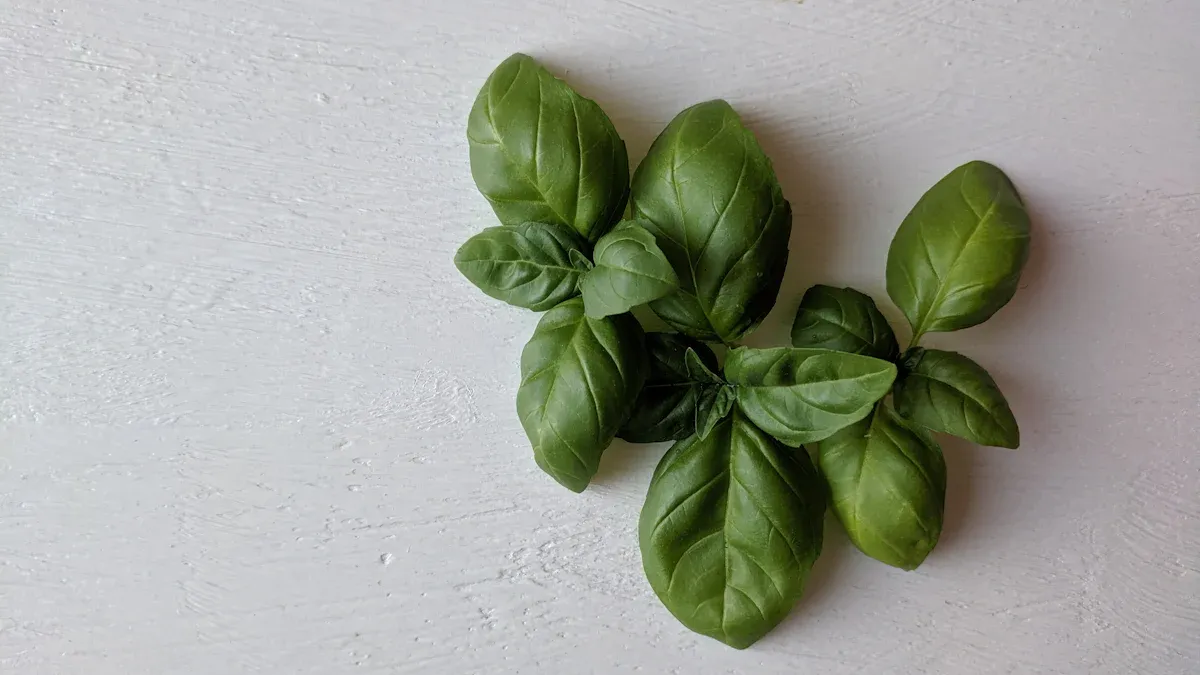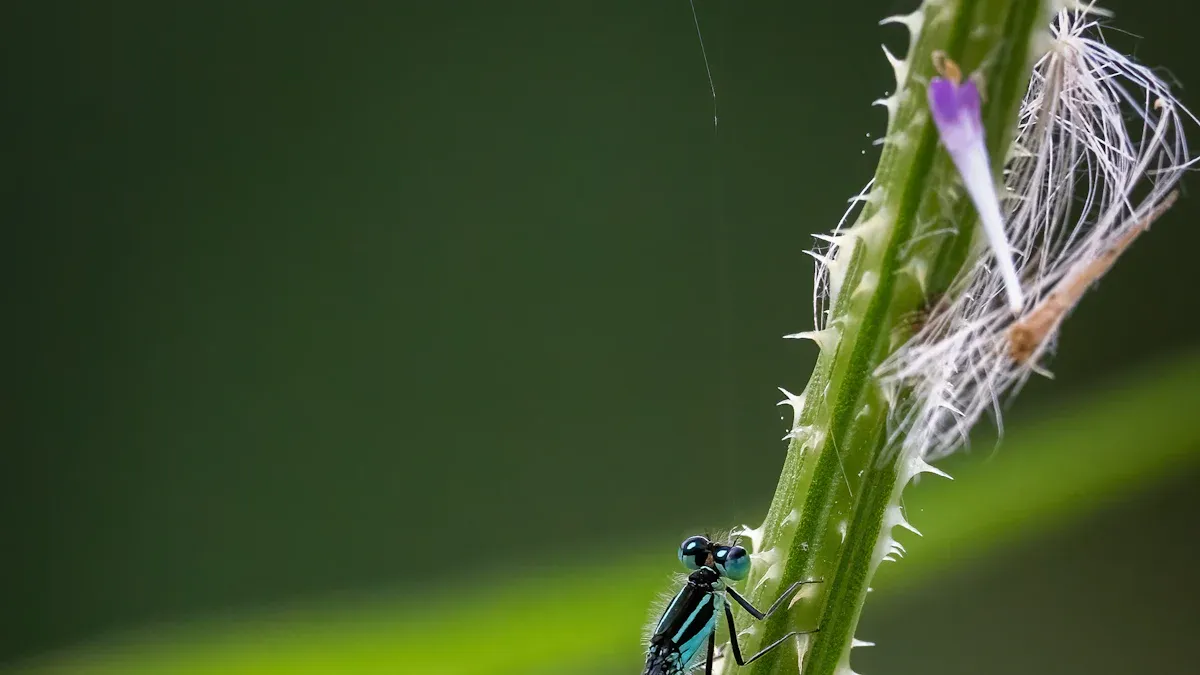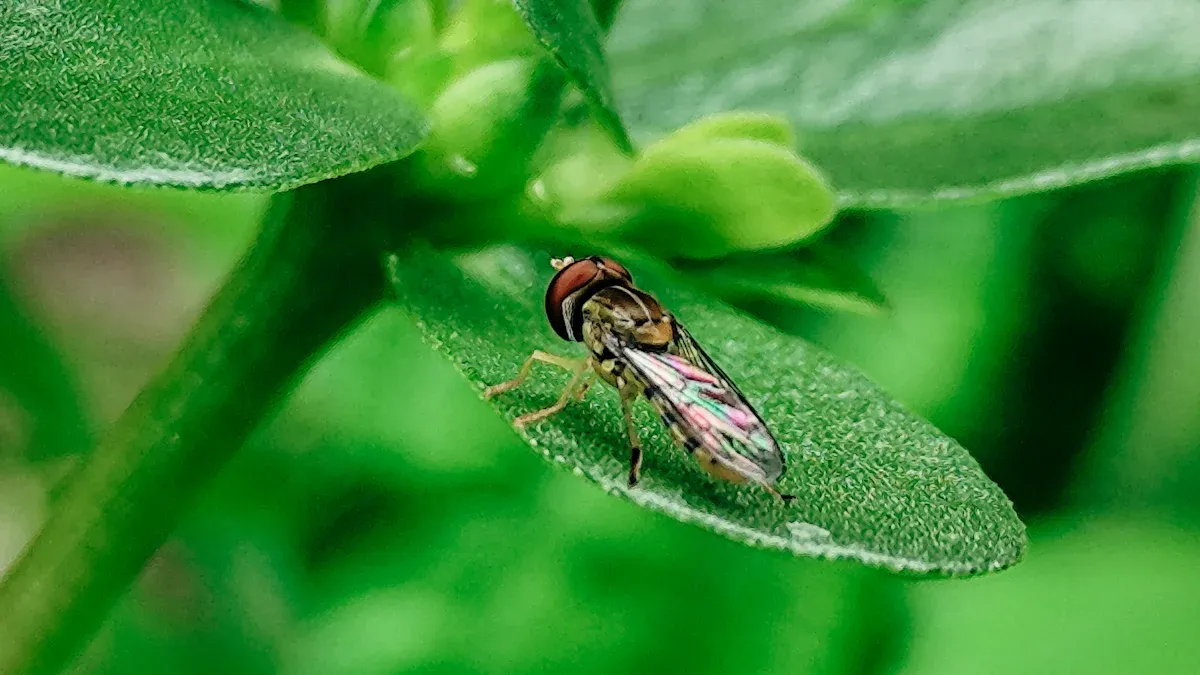
You walk outside, excited to check on your basil plant, only to find little bugs crawling on the leaves. Yikes! Identifying and managing these pests is crucial for keeping your basil healthy. Many gardeners worry about pests like Japanese beetles that munch on leaves, leaving behind damage. Early intervention can make all the difference!
Key Takeaways
Identify common pests like aphids, spider mites, whiteflies, and Japanese beetles to protect your basil. Look for specific signs such as curling leaves or sticky residue.
Use homemade insecticides like insecticidal soap or chili spray to effectively manage pest infestations. These solutions are easy to make and safe for your plants.
Regularly inspect your basil plants and maintain good gardening practices. This includes proper watering, soil preparation, and companion planting to prevent pest problems.
Little Bugs: Aphids

Identification
Aphids are small, soft-bodied insects that can be a real nuisance for your basil plant. You can easily spot them by their distinctive features. Here’s a quick comparison to help you identify aphids versus other pests:
Characteristic | Aphids | Other Pests |
|---|---|---|
Body Type | Soft-bodied, pear-shaped | Shiny black or brown (flea beetles) |
Size | Less than 3 mm long | Varies |
Coating | Waxy or shiny coating | Covered in white, waxy material (mealybugs) |
Behavior | Cluster in large numbers on undersides of leaves | Jumping habit (flea beetles) |
Feeding | Feed on sap, weakening host plant | Varies |
Residue | Leaves behind honeydew | N/A |
When you look closely at your basil leaves, you might see these little bugs clustered together, especially on the undersides. Their pear-shaped bodies and the sticky residue they leave behind can be telltale signs of an aphid infestation.
Symptoms
If aphids have invaded your basil, you’ll notice several symptoms that indicate their presence. Here are some common signs to watch for:
Curling or distorted leaves
Weakening of the plant
Accumulation of white cast skins on leaves
Sticky honeydew on foliage
Stunted growth
Distorted leaves
These symptoms can lead to weakened or disfigured plants, making it essential to act quickly. If you see any of these signs, it’s time to take action against these little bugs!
Aphids can also attract other pests, like ants, which feed on the honeydew they produce. Keeping an eye on your basil plant will help you catch these little bugs before they cause too much damage.
Little Bugs: Spider Mites

Identification
Spider mites are tiny, eight-legged arachnids that can wreak havoc on your basil plants. You might spot them by looking for these key features:
Color: They can appear in shades of red, yellow, black, or brown.
Size: These pests are very small, often hard to see without close inspection.
Webbing: Look for fine, silky webs around the leaves and stems.
Leaf Damage: Infested leaves may show light-colored or grayish spots, resembling downy mildew.
If you notice tiny moving dots on the undersides of your basil leaves, you might have a spider mite problem.
Symptoms
Spider mites can cause significant damage to your basil. Here are some common symptoms to watch for:
Stippling: You may see pale dots or a stippled appearance on the leaves.
Yellowing: Leaves might turn yellow or bronze as the infestation progresses.
Curling: The edges of the leaves may curl, indicating stress.
Premature Leaf Drop: Affected plants may drop leaves earlier than usual.
In severe cases, spider mites can reduce your basil’s yield by up to 53%. Keeping your basil well-watered and maintaining good air circulation can help prevent these little bugs from taking over.
Little Bugs: Whiteflies
Identification
Whiteflies are tiny, winged insects that can be a real headache for your basil plants. You can identify them by looking for these features:
Color: They are usually white or yellowish.
Size: Adult whiteflies are about 1/16 to 1/8 inch long.
Wings: They have two pairs of wings that look like tiny scales.
Behavior: When you disturb the plant, they often fly up in a cloud.
These little bugs tend to gather on the undersides of leaves, making them tricky to spot at first. If you see tiny white flies hovering around your basil, it’s time to investigate further!
Symptoms
Whitefly infestations can lead to several noticeable symptoms on your basil plants. Keep an eye out for:
Yellowing of leaves
Wilting plants
Premature leaf drop
Stem blanching
Stunted growth
Reduced crop yield
Complete plant death
As the infestation worsens, you might notice transparent spots on the leaves. They may also start curling and turning brown. If you see these signs, act quickly!
Whiteflies can spread easily among basil plants, especially if they’re close together. Previous infestations can leave sticky sap, which attracts these pests. Keeping your garden tidy and monitoring your plants regularly can help you catch these little bugs before they take over.
Little Bugs: Japanese Beetles
Identification
Japanese beetles are shiny, metallic-green pests that can cause significant damage to your basil plants. Here’s how to identify them:
Feature | Description |
|---|---|
Color | Shiny, metallic-green with brown/copper wing covers |
Size | About half an inch long |
Distinctive Markings | Iridescent coloring, easy to spot in sunlight |
Feeding Damage | Leaves behind lace or skeleton-like munched leaves |
You’ll often find adult beetles feeding on the upper leaves of your basil. They munch on the softer leaf tissue between the veins, creating a lace-like appearance. Here are some key features to help you spot them:
Metallic, blue-green body with coppery wing covers.
Oval shape, approximately 1/3″ to 1/2″ long and 1/4″ wide.
Tufts of white hair on each side of the body.
These little bugs typically appear in early summer and are most active during warm, sunny days.
Symptoms
When Japanese beetles invade your basil, you’ll notice some distinct symptoms. Their feeding leaves large, uneven holes and marks of chewing on the foliage. Here’s what to look for:
Lace-like leaves: The beetles consume the leaf tissue, leaving behind a skeleton of veins.
Uneven holes: You might see large holes throughout the plant, which can be quite noticeable due to their size.
Overall decline: Affected plants may show signs of stress, such as wilting or stunted growth.
If you see these symptoms, it’s essential to act quickly. Japanese beetles can cause aesthetic damage, but they can also weaken your basil plants over time. Keeping an eye on your plants will help you catch these little bugs before they do too much harm!
Control Methods for Little Bugs
Homemade Insecticides
When little bugs invade your basil plants, homemade insecticides can be a game-changer. They’re often easy to make and can be quite effective. Here are some tried-and-true recipes you can whip up right in your kitchen:
Insecticide Type | Preparation Method |
|---|---|
Insecticidal Soap | Mix 1.5 teaspoons of mild liquid soap with 1 quart of water. Spray on affected plants, preferably in the evening or early morning. |
Chilli Spray | For chili powder, mix 1 tablespoon with 1 quart of water and a few drops of mild soap. For fresh peppers, blend 0.5 cup with 1 cup of water, boil, cool, strain, and add soap. |
Neem Oil | Extracted from neem tree seeds, it disrupts insect life cycles and is biodegradable. Use preventatively by spraying before infestations. |
Vegetable Oil Spray | Mix 1 cup of vegetable oil with 1 tablespoon of soap. Then add 2 teaspoons of this mixture to 1 quart of water when ready to apply. It suffocates insects by blocking their breathing pores. |
These homemade solutions can help you tackle those pesky little bugs without resorting to harsh chemicals. Just remember to test any spray on a small area of the plant first to ensure it doesn’t cause damage.
Safety Tip: When using insecticides on edible plants like basil, always follow product labels strictly. Some insecticides may not be safe for edible crops. If you spray an insecticide without proper labeling, the plant may become unsafe for consumption. Rinse your basil with a vinegar solution followed by tap water to remove any pesticide residues.
Handpicking Techniques
Handpicking is another effective method to control little bugs on your basil plants. It’s simple and can be quite satisfying! Here’s how to do it:
Inspect Regularly: Check your basil plants frequently, especially the undersides of leaves where pests like to hide.
Use Gloves: Wear gloves to protect your hands while removing pests. This also prevents you from transferring any oils or scents that might deter beneficial insects.
Collect and Dispose: Gently remove the bugs and drop them into a container filled with soapy water. This will kill them quickly.
Encourage Beneficial Insects: Attract natural predators like ladybugs and lacewings to your garden. They love to feast on aphids and other little bugs.
By combining handpicking with homemade insecticides, you can effectively manage pest populations and keep your basil thriving. Remember, the sooner you act, the better your chances of saving your plants!
Prevention Strategies
Best Practices
Preventing little bugs from invading your basil plants starts with smart gardening choices. Here are some best practices to keep in mind:
Location Matters: Plant your basil away from areas watered by lawn sprinklers. This reduces moisture that attracts pests.
Soil Preparation: Ensure your soil is well-drained with a pH level of 6.0 to 6.5. Loosen the soil and remove weeds before planting.
Irrigation Techniques: Use drip or furrow irrigation instead of sprinklers. This helps maintain soil moisture without over-saturating it.
Companion Planting: Interplant basil with chard, kale, and herbaceous ornamentals. This helps reduce pest and disease buildup.
Timing is Key: Plant your basil at times that avoid peak pest seasons. This simple step can significantly lower pest pressure.
Maintenance Tips
Regular maintenance is crucial for keeping your basil healthy and pest-free. Here are some tips to follow:
Inspect Regularly: Check your plants often for holes, discoloration, or clusters of insects. Early detection is essential for managing pests effectively.
Use Neem Oil: Apply neem oil to manage aphids, especially in the late afternoon to protect pollinators.
Treat Japanese Beetles: Use pyrethrin spray or beneficial nematodes to reduce future infestations.
Deter Slugs: Organic slug and snail bait can help keep these pests away from your basil leaves.
Fertilize Wisely: Use a liquid organic fertilizer higher in nitrogen to support leaf growth.
Trim Regularly: Regularly trim the tops of your basil plants to encourage bushy growth and prevent flowering, which can affect flavor.
By following these best practices and maintenance tips, you can create a thriving environment for your basil plants while keeping little bugs at bay!
Identifying and managing pests on your basil plants is crucial for their health and yield. Proactive pest control not only keeps your basil thriving but also enhances its natural pest-repellent qualities. For reliable information, check out resources like Abell Pest Control and the University of California’s Integrated Pest Management program. 🌱
FAQ
What should I do if I find pests on my basil plant?
Act quickly! Remove pests by hand or use homemade insecticides to protect your plant.
How can I prevent pests from attacking my basil?
Keep your basil healthy with proper watering, good air circulation, and companion planting to deter pests.
Are homemade insecticides safe for my basil?
Yes, homemade insecticides are generally safe. Just ensure you rinse your basil before consuming it to remove any residues. 🌿


